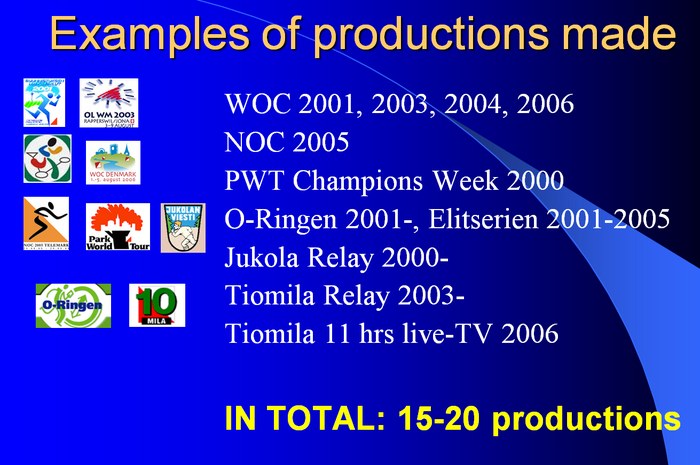Broadcasts
From OTV
Contents |
Historical TV broadcasts
Most WOC broadcasts since 2006 and several World Cup broadcasts the last years have been analyzed briefly, and key elements have been extracted from them. More information about how the broadcast analysis has been made here.
International broadcasts - analyzed
World Orienteering Championships:
- EOC 2012. Produced by SVT/Karel Jonak
- WOC 2011. Produced by Swiss TV(?)
- WOC 2010. Produced by Kruuva/Olli Härkki. Approximately 16-18 cameras were in use, one separate OB-bus was linked to arena, and at least 50 GPSs were used with GPSseuranta.
- WOC 2009. Produced by Czech TV/Karel Jonak
- WOC 2008. Produced by Czech TV/Karel Jonak
- WOC 2006. Produced by Film house(?). No live broadcast(?) - only recording in the evening
World Cup races / NORT:
- World Cup Liberec 2011. Produced by Czech TV/Karel Jonak
- NORT 2011 (Kruuva in Finland, ? in Sweden, Web-tv/Christian-Gedde Dahl in Norway)
- NORT 2010 (Kruuva, ?, Kruuva)
International broadcasts - not analyzed
- WOC 1997. An edited TV program made, but not sent.
- WOC 1999. No TV production.
- WOC 2001. Produced by YLE. First WOC with GPS-tracking, but not used in broadcast.
- WOC 2003 Produced by Swiss TV?
- WOC 2004. Produced by Film house(?)
- NOC 2005. Produced by TV2(?) . First and only Micr-o broadcast
- WOC 2005. No TV production
- WOC 2007. No TV production
- NORT 2009 (Kruuva, -, Kruuva/Markku Mäkäräinen)
- World Cup Final 2011
National broadcasts
- Finnish Huippuliiga - several broadcasts
- 10Mila (several years)
- Jukola
Selected webTV/big-screen productions
- Norwegian big-screen project: Big-screen production from all major national races in 2010 and 2011 (Produced by Christian Gedde-Dahl. Involved also Vegard Elgesem / Jørn Sundby)
- NORT 2011 Stage 3 is one of these productions which was streamed on WebTV
Key Elements in a TV Broadcast
Output from the SOFT TV Workshop February 2012:
Competition sequence
The following material was discussed related to the competition sequence:
- Route choice sequence for selected legs (challenges legs / legs to be followed by GPS)
- A must in every TV production from orienteering
- Either 2D or 3D (depending on terrain)
- PoV synchronized with GPS
- The best way to show PoV material is synchronized with GPS. Should be available for TV productions from orienteering
- Current leader pictures
- Very important - a leader’s chair is needed - important to show emotions / drama. This must be close to the run-in, and competitors must be informed about it.
- GPS
- Very important with focus on which parts of the GPS to show as part of the storytelling. This should be clear before the race. Important to use the GPS to tell the story - the parts which are important for the decisions in the race
- Enhancement of readability in GPS is very important (full names in white boxes, better information about what type of tracking – live / sync etc.)
- Use of Heartrate together with GPS-replay to visualize how heart-rate varies in different places in the course would be a very good supplement to the GPS tracking display (if possible with technology)
- Comment: TracTrac already has split times in the system. This can be used to give alarms etc.
- Look and feel of start/finish area
- General agreement that the look and feel of the start- and finish-area is very important. Important for the reputation of the sport. Must look like a Cross Country World Cup race – A-class. In the finish, nobody must run to the competitor to get the chip – it destroys the TV-pictures.
- One of the groups had in addition done some work on the story-telling part for the last part of the race. Two different scenarios:
- 1. Excitement until last competitor: Must wait until exact results
- 2. Last competitors is a looser: No way to show interesting stuff. You have 1 minute between each finisher. This can be filled with slow-mo and GPS-analysis / other analysis.
- Graphics
- Split time graphics: Same principle as in Cross Country Skiing, but own layout. Corporate layout to give professional look of the sport.
- On intermediate times, use control number + km, i.e. “Intermediate 1.9 km, Control 5”
- New technology
- Splits on every control: Not ripe for TV-productions yet. Use only for crew at first. Big potential for the relay. Who is dropping out of leading group etc.
Closing sequence
The closing sequence should contain the following elements according to the group which set up a detailed closing sequence:
- Results
- Analysis sequence (GPS replay selected part of course for Top 3)
- Interview
- Highlight of top 3 runners ranked: Slow-mo
- Flower ceremony - Top 3
- Closing clip
Template for broadcast analysis
Template for broadcast analysis
Examples of TV-productions from the IOF Arena Production Presentation:
